Mt. Uncle Distillery – Phil Barlow’s home
Today we are visited Beta Barra in the morning, Mt. Uncle Distillery in the afternoon, and in the evening we will be visited Phil Barlow’s home. At Phil Barlow’s home we will got an introduction into his life and family, attended a didgeridoo workshop and had a boomerang lesson. We also had the special opportunity to purchase a didgeridoo and a boomerang.
Beta Barra
Beta Barra is a local fish farm whose name is a pun of the Barramundi fish. Beta Barra is not an organic fish farm. However, they said that they only use salt and avoid using chemicals and the like. The owner of the fish farm told us that in Australia farmers generally try to be sustainable when they are farming. I found this statement very interesting that although a farm is not organic they are still practicing in a way that considers the environment and is sustainable.
Mt. Uncle Distillery
The Mt. Uncle Distillery is located in the Cairns Highlands on Mt. Uncle ( which is where it got its name from). It was quite a contrast to Beta Bara because it is a corporate farm that produces 1.8 bunches of bananas a year. Aside from bananas they also produce avocados. The climate there is so tropical and sunny that there is no surprise that it is considered the best climate in the world by the National Geographic. The company, like Beta Bara, is not organic. The owner told us that going organic is not realistic for the business due to the number of pests the crops receive. I think that it is very interesting how the business is thinking about the environmental aspect and the economic aspect of sustainability.
Credits: http://www.mtuncle.com/BRIDGES-CAFE.4.0.html,http://www.mtuncle.com/MT-UNCLE-DISTILLERY.3.0.html
Phil ‘s Home
I thought that the meeting with Phil , an aboriginal man, and his family was very interesting. First of all, we practiced throwing boomerangs and then we headed inside to have a discussion with Phil about his life and other issues affecting the aboriginal community. After that we ate a traditional meal that was cooked in the ground! After that we tried our best to play the didgeridoo. Finally, Phil gave all of us spirit animals ( mine was a crocodile) and we said our goodbyes. I will never forget the experience I had.
Boomerang
“A boomerang is a bent or curved piece of tough wood used by the Australian Aborigines as a throwing club, one which can be thrown so as to return to the thrower”. ( http://dictionary.reference.com/browse/boomerang+) . The word translates to mean ” a throwing stick that returns “. Although boomerangs were used as a hunting weapon long ago today it is used mainly for sports and recreation . ( http://en.wikipedia.org/wiki/Boomerang) . I remember throwing a fake toy boomerang as a child with my sisters ! Regardless of whether you are hunting or playing sports it is important to have the right throwing technique. The most efficient throw consists of vertical and straight movements instead of horizontal and flat ones. Always use your right hand to throw a boomerang properly. Grab it tightly near its edges. (http://www.ehow.com/info_8725013_australian-boomerangs.html) . We learned how to make a boomerang today. Click on the following link for easy step by step instructions on how to make one! ( http://www.ehow.com/how_8616521_make-australian-boomerang.html)
 ( http://upload.wikimedia.org/wikipedia/commons/thumb/b/be/Boomerang.jpg/300px-Boomerang.jpg)
( http://upload.wikimedia.org/wikipedia/commons/thumb/b/be/Boomerang.jpg/300px-Boomerang.jpg)- HI: 79
- LOW: 63

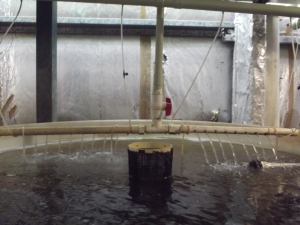
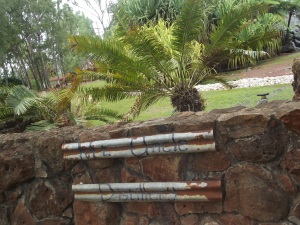
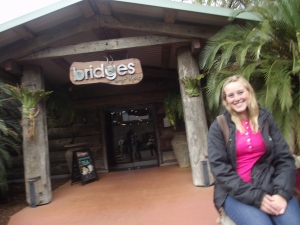
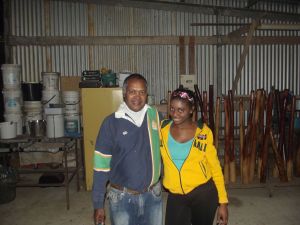
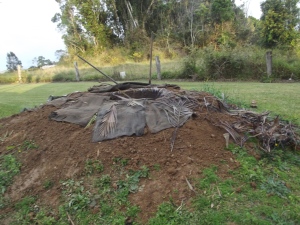
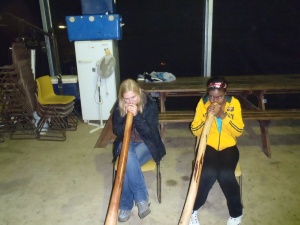
Betta Barra Hatchery was a very interesting Aquaculture facility, which plays a key role in the production of Barramundi for fish markets such as the Sydney Fish Market. There entire process was very cool, there facility produces two kinds of tropical fish, Barramundi and Black Brine, and raises the fish from hatchlings to about 100mm long and 10 grams. After this part of the process is done the fish are sold to a larger Aquaculture facility where they are grown to their market size of 3 to 5 kilos. The hatchery slipts up their fish into three sizes, small, medium and large, and gives each fish its own size and composition food pellet. The pellets were comprised of about 15% fish meal which is very low compared to more unsustainable Aquaculture practices. How these fish are slipt up is that every 10 days they grate the entire tank, in which the smaller fish slide through and the larger ones are caught. The fish that do not make it through the grate are then moved one tank to the right, once they get to the end of the row they move up to the next level. The entire hatchery works on a closed water system where the water is circulated between tanks, the water is ground water, the fact that the system is closed means that there is very little water waste. The system works very well and seems to be very efficient. The facility hopes to be more energy efficient in the future, they are looking at solar and wind, this is important because electricity is their highest cost coming out to around $3,000 Au every two months. The fact that this hatchery is not organic does not make a lot of difference at the monment since aquaculture is still just a growing field, also Aquaculture is a more sustainable alternative to wildfisheries which are taking out more fish then is sustainable in many of Australia’s waters. Overall it was an amazing place to go to and I am very happy were had the opportunity to go.
I thought that it was absolutely incredible to hear that Phil’s great grandfather was the sole survivor of the massacre of Aboriginal tribes-people in the tablelands area, I was shocked that he was able to make it through that horrific experience and continue life after that time. Phil had a very thorough description of the Aboriginal activites and traditions in the area and I found it very interesting to listen to the techniques which his family used to earn a living by hand-crafting didgeredoos and boomerangs in their workshop on their property. I had a blast learning to throw the boomerang and play the didgeredoos (or at least attempting to) and I think that the visit to Phil’s home was an extremely effective method of opening my eyes to the world of Aboriginal lifestyle and culture as a whole and how different it is from that of our more western belief systems.
Mt. Uncle Distillery also produces award winning spirits and liqueurs on site at the plantation and has a cafe that you can eat at, buy spirits and liqueurs, coffee, and other products. They also offer coffee beans that are grown locally and over 50 types of tea. The tropical Tablelands climate couldn’t be better because they don’t need much water for the crops. Rain provides for most of the crops and they installed drip irrigation for absolute necessity. Drip irrigation is much more efficient than a normal sprinkler because it focuses water on the roots of a plant and/or tree to reduce water waste rather than dispersing a lot of water over a large area.